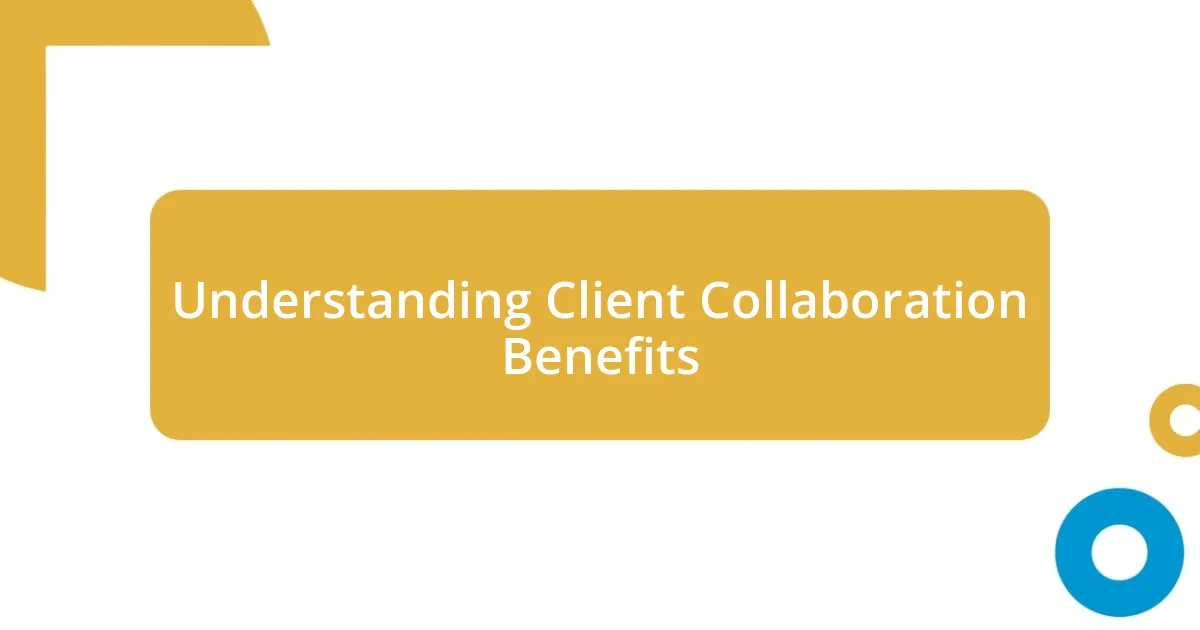Key takeaways:
- Client collaboration enhances trust and fosters a partnership mentality through open communication and integration of client ideas.
- Establishing clear expectations and measurable goals improves accountability, motivation, and project alignment.
- Creating a supportive environment encourages creativity and strengthens collaboration, leading to innovative solutions.
- Evaluating outcomes and incorporating feedback facilitates continuous improvement and adaptation in future projects.

Understanding Client Collaboration Benefits
Collaboration with clients can bring remarkable benefits, both for your projects and your relationship with them. I recall a time when I was working on a marketing campaign, and by involving the client in brainstorming sessions, we came up with ideas that surpassed my expectations. It’s incredible how two minds can align to produce innovative results—have you ever experienced that kind of synergy?
One of the key advantages I’ve observed is the enhancement of trust between you and your client. When they see their ideas and feedback being integrated into the project, it not only makes them feel valued but also reinforces a partnership mentality. I remember a client who initially had reservations about my approach, but once we started collaborating closely, their confidence grew. It made me realize just how vital open communication is.
Another benefit is the potential for more tailored solutions. In one project, I was able to adjust my strategy significantly after receiving direct input from the client. It turned out that their insights were grounded in unique aspects of their industry that I hadn’t considered. Isn’t it fascinating how tapping into a client’s expertise can ultimately lead to better outcomes for everyone involved?

Establishing Effective Communication Methods
Establishing effective communication methods with clients is essential for fostering a collaborative atmosphere. During a recent project, I found that scheduling regular check-ins transformed our interaction. These meetings became a space for both parties to share updates, discuss concerns, and celebrate progress, creating a rhythm of accountability that really motivated everyone involved.
To further enhance communication, I’ve found the following techniques helpful:
- Active Listening: I always make it a point to listen attentively, ensuring the client feels heard.
- Clear and Concise Messaging: I avoid jargon and keep my language simple to prevent misunderstandings.
- Feedback Loops: Creating opportunities for the client to give ongoing feedback helps refine the project continuously.
- Visual Aids: I often incorporate visuals like charts or infographics during discussions, as they help clarify concepts and engage clients more effectively.
Incorporating these methods not only enriches the client experience but also aligns our goals, allowing for a smoother, more successful collaboration.

Setting Clear Expectations and Goals
Setting clear expectations and goals is crucial when embarking on a collaborative journey with clients. I remember a project where we set measurable objectives right from the start, which proved invaluable. With specific targets outlined, we could track our progress and celebrate small wins, creating a sense of momentum that kept everyone motivated. Have you ever noticed how satisfying it is to tick items off a to-do list?
Another strong memory involves a client who had high hopes for their project but was unsure of what success looked like. By guiding them to articulate their vision and breaking it down into achievable goals, we not only boosted their confidence but also aligned our efforts effectively. It’s amazing how clarity can turn uncertainty into a shared purpose, isn’t it? It truly transformed our working relationship into a partnership where both sides felt committed to the same outcome.
When expectations are set collaboratively, it fosters accountability on both ends. I have seen clients who once felt like they were on the sidelines become actively engaged in the process. By establishing checkpoints together, it became easier for us to adjust the course as needed. In my experience, understanding and adjusting to client expectations often led to more innovative solutions, effectively redefining typical project limitations.
| Expectation/Goal Setting | Impact |
|---|---|
| Setting Measurable Objectives | Creates accountability and motivation |
| Guiding Client Vision Articulation | Aligns efforts and boosts confidence |
| Establishing Checkpoints | Facilitates adjustment and innovation |

Fostering a Collaborative Work Environment
Creating a collaborative work environment goes beyond mere communication; it’s about cultivating trust and openness. I remember a client who was apprehensive about sharing their ideas because they feared criticism. By actively encouraging them to express their thoughts, I made it clear that all ideas were valued. When I saw their confidence grow, it reinforced my belief that a supportive atmosphere can unlock incredible creativity.
Another insight that I’ve gathered over time is the importance of shared spaces, both physical and virtual. For instance, during a large project, we transformed our meetings into brainstorming sessions held at a cozy café. The relaxed environment seemed to invite more spontaneous ideas and fostered a sense of camaraderie. Have you ever noticed how a change of scenery can spark inspiration? It certainly worked wonders for us.
Moreover, I’ve learned that celebrating small victories along the way is vital. I once celebrated a project milestone with a simple thank-you email that highlighted individual contributions. The positive reactions were heartwarming! This practice not only recognized the team’s hard work but also encouraged continued collaboration. When everyone feels acknowledged, it sets the stage for a genuinely collaborative spirit.

Managing Conflicts and Challenges
Navigating conflicts in client collaboration can feel overwhelming at times, but I’ve discovered that open dialogue is often the best approach. I recall a project where a disagreement arose regarding the direction of our work. Instead of letting it fester, I invited the team and the client to a candid discussion. It was surprising how a simple conversation transformed tension into creativity. Have you ever experienced how talking it out can dissolve misunderstandings?
Challenges often emerge from misaligned expectations, and I’ve learned to address them head-on. I once worked with a client who had a very different interpretation of our project’s scope than I did. Rather than pushing forward and risking major setbacks, I took the initiative to recalibrate our focus. After laying everything out, we were able to realign our priorities. This experience taught me that it’s not just about fixing problems but about using them as opportunities for growth.
Then there are the moments when external pressure creates challenges. During one project, an unexpected market shift threatened our timeline. Instead of panicking, I gathered the team to brainstorm solutions, which led to innovative adjustments we hadn’t initially considered. Have you ever noticed how adversity can spark creativity? It reminded me that embracing challenges together with clients can foster resilience and partnership, strengthening our collaboration moving forward.

Evaluating Collaboration Outcomes and Improvements
Evaluating the outcomes of our collaborations can be an eye-opening experience. I remember wrapping up a project with a client and stepping back to assess what went well and what fell short. We created a shared feedback document where everyone could share their thoughts. It was illuminating to uncover insights that I hadn’t considered, and it reaffirmed how critical it is to continuously learn and adapt.
Often, I find that improvement comes from honest reflection. In one instance, after a particularly complex project, the team and I conducted a retrospective where we discussed our successes and failures. I was struck by how different perceptions of the collaboration surfaced—what I thought was a missed opportunity, others viewed as a valuable lesson. This process showed me that diverse perspectives significantly enhance our learning and growth.
Moving forward, I make it a priority to implement changes based on our evaluations. I recall a client meeting where we addressed past obstacles openly, and by doing so, we set clear strategies for future projects. It’s fascinating how small adjustments can lead to exponential improvements. Have you ever felt the shift in energy after making those tweaks? Recognizing the power of evolution in our collaborations not only strengthens relationships but also paves the way for more innovative outcomes.














